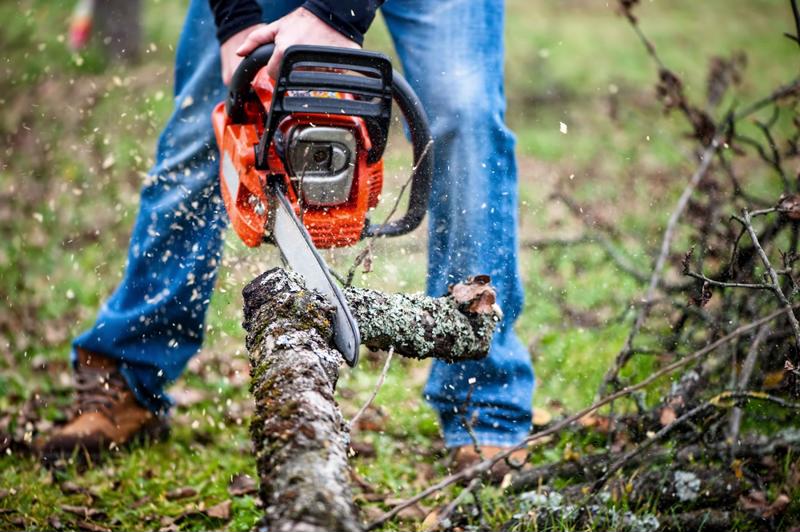Landscaping isn't the most dangerous job out there, but that doesn't mean you or your employees should treat it like a walk in the park. The fact of the matter is that any workers who interact with heavy machinery should have the training and protective equipment they need to not only feel safe, but to operate state-of-the-art tools with the care and precision that makes for a job well done.
However, just throwing money at protective equipment without really knowing what will help isn't going to do much for your employees or your business. If you haven't taken a hard look at the level of safety your employees uphold when they go out to mow lawns, fell trees and anything else your clients require, it's about time you did.
 Jeans and chainsaws is a dangerous combination.
Jeans and chainsaws is a dangerous combination.Do your employees really need safety gear?
Some might think that landscaping companies that don't offer the highest quality protective equipment are cutting corners when it comes to employee safety. Your expenses are dictated by your budget, though, and if the cash isn't there, it might seem like a smart fiscal move to hold off on a new selection of hard hats and chaps.
However, it's actually better to hedge your bets and outfit all of your employees with the safety equipment you can afford. According to the U.S. Centers for Disease Control and Prevention, landscape service workers experience an inordinate percentage of occupational injuries. Despite only making up 0.8 percent of the overall workforce, employees of landscaping companies are subject to 3.5 percent of all on-the-job injuries. Moreover, it can be incredibly hard to predict where these threats come from, as falling tree limbs or mishandling of chainsaws and other potentially dangerous equipment can strike at any time. In fact, landscapers are more likely than the general workforce to suffer serious injuries related to falls (22 percent), falling objects (17 percent) and electric shocks (17 percent).
Cut to the chase
There are a few simple methods any landscaping company can implement to reduce the likelihood of occupational injuries. Working in teams when lifting heavy objects can help, but when the job in question requires the use of a chainsaw, teamwork isn't always the best option.
"Even the most experienced landscaper will see their chainsaw kick back every now and then."
Instead, look for apparel specifically designed to reduce the risk of severe cutting injuries. During the course of normal chainsaw operation, even the most experienced landscaper will see their chainsaw kick back every now and then. Fortunately, chainsaw chaps can turn a severe injury into a mild or moderate one. Husqvarna offers chaps made with five layers of cut-resistant polyester that are up to regulations set by the Occupational Safety and Health Administration. As an added protective bonus, look for pairs that are coated with PVC – while no body armor, these just might save your workers' lives in the worst-case scenarios.
Keeping your head about you
While you should equip your employees with gear that keeps them safe from the machines they operate, the trees that chainsaws work on is arguably more of a threat to your workers than the fast-moving blades themselves. If your company handles a lot of tree-removal or limb-trimming jobs, protecting employees from threats from above is essential.
Fortunately, Husqvarna has you covered – literally. If you just need protection from blunt force trauma, the Pro Forestry Hard Hat is your best option. However, with so much particulate matter swirling around on work sites, a simple head covering might only offer the minimum level of protection. Instead, consider if your employees need more comprehensive coverage from safety equipment like the Functional Hard Hat Forestry Helmet System. Not only do your workers get protection from falling object about their heads, but this system also includes a face shield to block any projectile splinters or stones heading toward their faces. As if that wasn't enough, built-in adjustable ear muffs reduce ambient noise by an average of 25 decibels.
When disaster strikes
As much as you might want to protect your employees and as careful as they are to avoid accidents, injuries are bound to occur no matter what you do. However, it's how you prepare for these worst-case scenarios that can turn a life-threatening injury into a moderate one.
It sounds like common sense, but every time you send your crew out for a job, make sure they bring a first-aid kit along with them. This shouldn't be the same kind you have in your house, though. With professional-grade equipment, you should have a professional-grade field kit that comes with blood stoppers, pressure pads and wound washes. In the event of a serious injury, how you respond in the first few moments could potentially save a life.